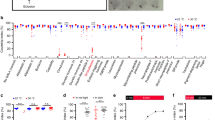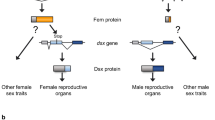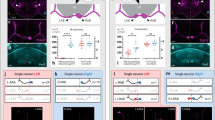Abstract
Doublesex proteins, which are part of the structurally and functionally conserved Dmrt gene family, are important for sex determination throughout the animal kingdom. We inserted Gal4 into the doublesex (dsx) locus of Drosophila melanogaster, allowing us to visualize and manipulate cells expressing dsx in various tissues. In the nervous system, we detected differences between the sexes in dsx-positive neuronal numbers, axonal projections and synaptic density. We found that dsx was required for the development of male-specific neurons that coexpressed fruitless (fru), a regulator of male sexual behavior. We propose that dsx and fru act together to form the neuronal framework necessary for male sexual behavior. We found that disrupting dsx neuronal function had profound effects on male sexual behavior. Furthermore, our results suggest that dsx-positive neurons are involved in pre- to post-copulatory female reproductive behaviors.
This is a preview of subscription content, access via your institution
Access options
Subscribe to this journal
Receive 12 print issues and online access
$209.00 per year
only $17.42 per issue
Buy this article
- Purchase on Springer Link
- Instant access to full article PDF
Prices may be subject to local taxes which are calculated during checkout







Similar content being viewed by others
References
Dickson, B.J. Wired for sex: the neurobiology of Drosophila mating decisions. Science 322, 904–909 (2008).
Villella, A. & Hall, J.C. Neurogenetics of courtship and mating in Drosophila. Adv. Genet. 62, 67–184 (2008).
Zarkower, D. Invertebrates may not be so different after all. Novartis Found. Symp. 244, 115–126; discussion 126–135, 203–116, 253–117 (2002).
Williams, T.M. et al. The regulation and evolution of a genetic switch controlling sexually dimorphic traits in Drosophila. Cell 134, 610–623 (2008).
Ng, C.S. & Kopp, A. Sex combs are important for male mating success in Drosophila melanogaster. Behav. Genet. 38, 195–201 (2008).
Bray, S. & Amrein, H. A putative Drosophila pheromone receptor expressed in male-specific taste neurons is required for efficient courtship. Neuron 39, 1019–1029 (2003).
Dauwalder, B. Systems behavior: of male courtship, the nervous system and beyond in Drosophila. Curr. Genomics 9, 517–524 (2008).
Waterbury, J.A., Jackson, L.L. & Schedl, P. Analysis of the doublesex female protein in Drosophila melanogaster: role on sexual differentiation and behavior and dependence on intersex. Genetics 152, 1653–1667 (1999).
Shirangi, T.R., Dufour, H.D., Williams, T.M. & Carroll, S.B. Rapid evolution of sex pheromone-producing enzyme expression in Drosophila. PLoS Biol. 7, e1000168 (2009).
Manoli, D.S. et al. Male-specific fruitless specifies the neural substrates of Drosophila courtship behavior. Nature 436, 395–400 (2005).
Demir, E. & Dickson, B.J. fruitless splicing specifies male courtship behavior in Drosophila. Cell 121, 785–794 (2005).
Kimura, K., Ote, M., Tazawa, T. & Yamamoto, D. Fruitless specifies sexually dimorphic neural circuitry in the Drosophila brain. Nature 438, 229–233 (2005).
Lee, G. et al. Spatial, temporal, and sexually dimorphic expression patterns of the fruitless gene in the Drosophila central nervous system. J. Neurobiol. 43, 404–426 (2000).
Rideout, E.J., Billeter, J.C. & Goodwin, S.F. The sex-determination genes fruitless and doublesex specify a neural substrate required for courtship song. Curr. Biol. 17, 1473–1478 (2007).
Villella, A. & Hall, J.C. Courtship anomalies caused by doublesex mutations in Drosophila melanogaster. Genetics 143, 331–344 (1996).
Lee, G., Hall, J.C. & Park, J.H. Doublesex gene expression in the central nervous system of Drosophila melanogaster. J. Neurogenet. 16, 229–248 (2002).
Sanders, L.E. & Arbeitman, M.N. Doublesex establishes sexual dimorphism in the Drosophila central nervous system in an isoform-dependent manner by directing cell number. Dev. Biol. 320, 378–390 (2008).
Billeter, J.C. et al. Isoform-specific control of male neuronal differentiation and behavior in Drosophila by the fruitless gene. Curr. Biol. 16, 1063–1076 (2006).
Shirangi, T.R., Taylor, B.J. & McKeown, M. A double-switch system regulates male courtship behavior in male and female Drosophila melanogaster. Nat. Genet. 38, 1435–1439 (2006).
Kimura, K., Hachiya, T., Koganezawa, M., Tazawa, T. & Yamamoto, D. Fruitless and doublesex coordinate to generate male-specific neurons that can initiate courtship. Neuron 59, 759–769 (2008).
Siwicki, K.K. & Kravitz, E.A. Fruitless, doublesex and the genetics of social behavior in Drosophila melanogaster. Curr. Opin. Neurobiol. 19, 200–206 (2009).
Camara, N., Whitworth, C. & Van Doren, M. The creation of sexual dimorphism in the Drosophila soma. Curr. Top. Dev. Biol. 83, 65–107 (2008).
Baker, B.S. & Ridge, K.A. Sex and the single cell. I. On the action of major loci affecting sex determination in Drosophila melanogaster. Genetics 94, 383–423 (1980).
Belote, J.M. & Baker, B.S. Sexual behavior: its genetic control during development and adulthood in Drosophila melanogaster. Proc. Natl. Acad. Sci. USA 84, 8026–8030 (1987).
Bernstein, A.S., Neumann, E.K. & Hall, J.C. Temporal analysis of tone pulses within the courtship songs of two sibling Drosophila species, their interspecific hybrid, and behavioral mutants of D. melanogaster. J. Insect Behav. 5, 15–36 (1992).
Kopp, A., Duncan, I., Godt, D. & Carroll, S.B. Genetic control and evolution of sexually dimorphic characters in Drosophila. Nature 408, 553–559 (2000).
Montell, C. A taste of the Drosophila gustatory receptors. Curr. Opin. Neurobiol. 19, 345–353 (2009).
von Schilcher, F. & Hall, J.C. Neural topography of courtship song in sex mosaics of Drosophila melanogaster. J. Comp. Physiol. A Neuroethol. Sens. Neural Behav. Physiol. 129, 85–95 (1979).
Clyne, J.D. & Miesenbock, G. Sex-specific control and tuning of the pattern generator for courtship song in Drosophila. Cell 133, 354–363 (2008).
Possidente, D.R. & Murphey, R.K. Genetic control of sexually dimorphic axon morphology in Drosophila sensory neurons. Dev. Biol. 132, 448–457 (1989).
MacDonald, J.M. et al. The Drosophila cell corpse engulfment receptor Draper mediates glial clearance of severed axons. Neuron 50, 869–881 (2006).
Hay, B.A., Wolff, T. & Rubin, G.M. Expression of baculovirus P35 prevents cell death in Drosophila. Development 120, 2121–2129 (1994).
Sweeney, S.T., Broadie, K., Keane, J., Niemann, H. & O'Kane, C.J. Targeted expression of tetanus toxin light chain in Drosophila specifically eliminates synaptic transmission and causes behavioral defects. Neuron 14, 341–351 (1995).
Santel, A., Winhauer, T., Blumer, N. & Renkawitz-Pohl, R. The Drosophila don juan (dj) gene encodes a novel sperm specific protein component characterized by an unusual domain of a repetitive amino acid motif. Mech. Dev. 64, 19–30 (1997).
Villella, A., Peyre, J.B., Aigaki, T. & Hall, J.C. Defective transfer of seminal-fluid materials during matings of semi-fertile fruitless mutants in Drosophila. J Comp. Physiol. A Neuroethol. Sens. Neural Behav. Physiol. 192, 1253–1269 (2006).
Billeter, J.C., Rideout, E.J., Dornan, A.J. & Goodwin, S.F. Control of male sexual behavior in Drosophila by the sex determination pathway. Curr. Biol. 16, R766–R776 (2006).
Hall, J.C. Portions of the central nervous system controlling reproductive behavior in Drosophila melanogaster. Behav. Genet. 7, 291–312 (1977).
Hall, J.C. Control of male reproductive behavior by the central nervous system of Drosophila: dissection of a courtship pathway by genetic mosaics. Genetics 92, 437–457 (1979).
Ferveur, J.F. & Greenspan, R.J. Courtship behavior of brain mosaics in Drosophila. J. Neurogenet. 12, 205–226 (1998).
Manoli, D.S. & Baker, B.S. Median bundle neurons coordinate behaviours during Drosophila male courtship. Nature 430, 564–569 (2004).
Broughton, S.J., Kitamoto, T. & Greenspan, R.J. Excitatory and inhibitory switches for courtship in the brain of Drosophila melanogaster. Curr. Biol. 14, 538–547 (2004).
Häsemeyer, M., Yapici, N., Heberlein, U. & Dickson, B.J. Sensory neurons in the Drosophila genital tract regulate female reproductive behavior. Neuron 61, 511–518 (2009).
Yang, C.H. et al. Control of the postmating behavioral switch in Drosophila females by internal sensory neurons. Neuron 61, 519–526 (2009).
Lazareva, A.A., Roman, G., Mattox, W., Hardin, P.E. & Dauwalder, B. A role for the adult fat body in Drosophila male courtship behavior. PLoS Genet. 3, e16 (2007).
Rong, Y.S. & Golic, K.G. Gene targeting by homologous recombination in Drosophila. Science 288, 2013–2018 (2000).
Billeter, J.C. & Goodwin, S.F. Characterization of Drosophila fruitless-gal4 transgenes reveals expression in male-specific fruitless neurons and innervation of male reproductive structures. J. Comp. Neurol. 475, 270–287 (2004).
Acknowledgements
We thank T. Aigaki, P. Breslin, B. Dickson, J.-F. Ferveur, F. Hirth, G. Lee, R. Renkawitz-Pohl, Y. Rong and S. Sweeney for providing valuable reagents and protocols, and J.-C. Billeter, J. Hall, J. Levine, B. Oliver and S. Waddell for comments on the manuscript. We also thank members of the Goodwin laboratory for helpful discussions. This work was supported by grants from the Wellcome Trust.
Author information
Authors and Affiliations
Contributions
E.J.R., A.J.D., M.C.N. and S.F.G. designed experiments and wrote the paper. E.J.R., A.J.D. and M.C.N. all contributed equally to performing the experiments. S.E. provided technical assistance.
Corresponding author
Ethics declarations
Competing interests
The authors declare no competing financial interests.
Supplementary information
Supplementary Text and Figures
Supplementary Figures 1–6 and Supplementary Tables 1 and 2 (PDF 11079 kb)
Supplementary Video 1
Sexually dimorphic dsxGAL4 neural circuitry in 5 d adult brains. Movies generated from confocal optical slice stacks, moving ventrally to dorsally (anterior top), of dsxGAL4 driving UAS-mCD8::GFP (membrane-bound GFP) male (top) and female (bottom) whole sample brains. Presenting comparative representations of the sexually dimorphic axonal projection patterns associated with the dsxGAL4-expressing neuronal cell bodies with respect to surrounding anatomical landmarks. These stacks were used to generate the maximal Z projections represented in figures 2b and 2e. Neuronal projections expressing UAS-mCD8::GFP (membrane-bound GFP) stained with anti-mCD8 antibody (green). Neuropil counterstained with anti-nC82 Mab (magenta). (MOV 3821 kb)
Supplementary Video 2
Sexually dimorphic dsxGAL4 neural circuitry in 5 day adult ventral nerve cords. Movies generated from confocal optical slice stacks, moving ventrally to dorsally (anterior top), of dsxGAL4 driving UAS-mCD8::GFP (membrane-bound GFP) male (left) and female (right) whole sample ventral nerve cords. Presenting comparative representations of the sexually dimorphic axonal projection patterns associated with the dsxGAL4-expressing neuronal cell bodies with respect to surrounding anatomical landmarks. These stacks were used to generate the maximal Z projections represented in figures 2i and 2k. Neuronal projections expressing UAS-mCD8::GFP (membrane-bound GFP) stained with anti-mCD8 antibody (green). Neuropil counterstained with anti-nC82 Mab (magenta). (MOV 3663 kb)
Supplementary Video 3
Wild-type male and UAS-TNTG;dsxGAL4 female. A wild-type male is shown courting and then copulating with a UAS-TNTG;dsxGAL4 female. (MOV 15634 kb)
Rights and permissions
About this article
Cite this article
Rideout, E., Dornan, A., Neville, M. et al. Control of sexual differentiation and behavior by the doublesex gene in Drosophila melanogaster. Nat Neurosci 13, 458–466 (2010). https://doi.org/10.1038/nn.2515
Received:
Accepted:
Published:
Issue Date:
DOI: https://doi.org/10.1038/nn.2515
This article is cited by
-
A Neural Circuit Controlling Virgin Female Aggression Induced by Mating-related Cues in Drosophila
Neuroscience Bulletin (2023)
-
Cellular diversity and gene expression profiles in the male and female brain of Aedes aegypti
BMC Genomics (2022)
-
Sexually dimorphic peripheral sensory neurons regulate copulation duration and persistence in male Drosophila
Scientific Reports (2022)
-
Transgenic expression of Nix converts genetic females into males and allows automated sex sorting in Aedes albopictus
Communications Biology (2022)
-
A male-specific doublesex isoform reveals an evolutionary pathway of sexual development via distinct alternative splicing mechanisms
Communications Biology (2022)



